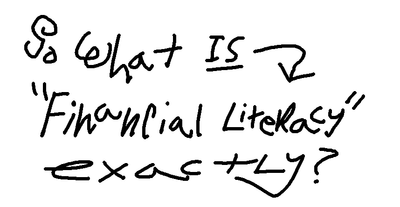Financial literacy is the capability of making good decisions with money (synonym: “adulting”). Despite being the wealthiest country in the world, the US doesn’t crack the top 10 in global financial literacy. To add insult to injury, our financial literacy problem has actually gotten worse in recent years.
The picture is particularly bleak for millennials. A MassMutual study found that fewer than 20% of respondents age 18-34 could correctly answer basic questions about personal finance. Our institutions are failing to educate young people on an essential life skill, and I’m not talking about making a sourdough starter.
We’re aware the chart only goes to 2018… can the nitpickers take a day off?
Formal Schooling
Why didn’t you learn this in high school?
If you did, consider thanking your local and state representatives, because curriculums are determined on a state-by-state basis. Compared to previous years, more states are requiring financial literacy courses, but the majority of the country is still woefully underserved. Imagine how prepared you would’ve been for real life if you had learned the Greek python triangle formula AND how to make sound long-term investments?
source: 2020 Survey of the States by CEE
Okay, so there’s a policy dimension to this… but what about the teachers?
Only 1 in 5 teachers feel comfortable teaching a financial literacy course, but as lovers of knowledge, more than 70% of teachers are “willing to learn” (classic teacher move). Fortunately, the cost of providing teacher development is extremely low and there are hundreds of non-profits that will do it for free. States, if you’re reading this…
Policy… teacher preparedness… anything else?
Let me give you another reason to hate standardized tests: they force schools to put a disproportionate emphasis on the subjects that show up on those tests (English, math, etc.), leaving little time to focus on a topic like personal finance. I’m not saying a simple solution would be to make all the standardized math questions related to money… but I’m not saying that wouldn’t work either.
Look, I’m no education guru (no relation to Rudolf Steiner… he never submitted a 23andMe test so I can’t be 100% sure), but if we’re gonna waste our precious youthtime learning to play badminton and getting sex education from a teacher who thinks effective pedagogy includes putting a condom on his head (this actually happened at my high school), can we also find a few minutes to help high schoolers develop good money habits? No? We can’t? Darn.
To all the school boards out there, let me remind you that where formal education falls short, the burden shifts to parents. Let’s talk about that.
At home
Why don’t parents teach their kids about money?
It’s not that parents don’t want to impart money savviness unto their children, it’s just that most parents are badly misinformed… and there are a lot of poor spending habits out there (see: $1 trillion in American owned credit card debt). Unfortunately, spending habits — like the treatment of waiters who forget to put a lemon wedge in the water glass — is one of the big things kids emulate in their parents.
For the parents that are talking to their kids about money, cheers to them! They are doing their kids a great service. Sadly, the majority of conversations about financial literacy in the home rarely extend beyond saving, budgeting, and building credit. Which is the equivalent of teaching someone how to play checkers but not telling them about double jumps, “king me,” or the role of unrelenting, overly personal trash talk that should drive close relationships right up to the edge (but not over it).
Financial Services
Follow the money.
Financial institutions make money off of people… who have money. Young people don’t usually have bags of cash lying around (I haven’t seen many), which means much of the educational content produced by brokerages, banks, and other financial institutions isn’t targeted at us. Have you ever sat through an “intro to investing” webinar delivered by a traditional brokerage? They’re, uh, how do we put this… really boring. Our Marketing Ops guy Ben volunteered to check one out and he’s still sleeping.
According to the 2018 Guide to Financial Marketing, “attracting a younger audience” ranked ninth on the priorities list of bank marketers. You know what ranks ninth on my personal list of priorities? Fixing the bumper on my car. Priorities that rank 9th don’t happen.
Technology Companies
The tech sector is very hot on finance.
When the public sector falls short and the private sector’s incumbents are dinosaurs, you can expect tech to swoop in. We live in an age where “fintech” apps run amok — apps for budgeting (Mint, YNAB), investing (Robinhood, Wealthfront, Betterment, Acorns, SoFi), subscription tracking (Truebill, Trim), cash transfer (Venmo, Cash App)… it’s a long list getting longer by the day.
Tech is stepping up in a big way to help young people get a better handle on their finances. That’s great. However, a staggering percentage of 18-35 year-olds (golden years amirite?) still don’t feel comfortable or confident about how to get started when it comes to investing. Long term, that’s a huge problem.
We all have places to be…
Let’s wrap up with some math because that’s a fun way to wrap up.
The financial literacy gap in America is foreshadowing some devastating effects on the future wealth of 99% of the population. Hell, some estimates say a lack of personal finance knowledge cost Americans $307 billion in 2019 alone.
Right now, 40% of millennials (16 MILLION people) are not investing because either they don’t know how, are afraid to lose money, don’t trust the stock market, or don’t think they have the time to manage their investments. Those are understandable hesitations for folks who never got a sturdy educational footing, but as far as hesitations go, these are surmountable.
And as far as surmounting goes, we think it’s the learning part that matters most. Tech is creating an awesome suite of tools, but someone has to be the true “step zero.” That’s what Big Later is all about.
Don't listen to her.




